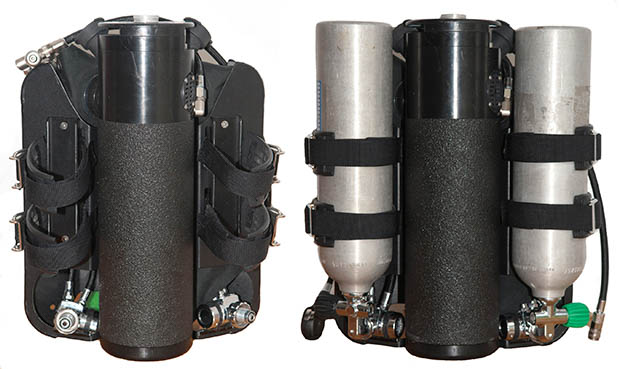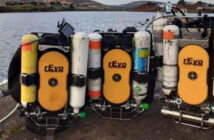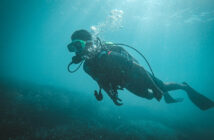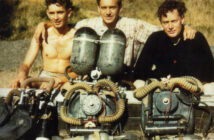Warm & moist air: This is due to the chemical reaction of the carbon dioxide being removed from the gas in the loop by the scrubber material. The by-product of this action is heat and moisture. This helps the diver to stay warmer and hydrated longer. The gas a diver breathes from an open circuit (SCUBA) cylinder is “refrigerated” and will drop the diver’s core body temperature quickly.
Time: 2 to 3 hours of gas. With open circuit, the diver inhales the breathing gas and exhales what they do not use into the water column. With a CCR, the diver inhales the breathing gas and exhales what they do not metabolize – back into the loop. That gas is then recycled. As every lung full of gas goes much further, small cylinders can be used.
 Silence: Dives are quiet and peaceful as there is no noise from regulators and bubbles. This allows the diver to get much closer to the wildlife and have a more relaxing experience.
Silence: Dives are quiet and peaceful as there is no noise from regulators and bubbles. This allows the diver to get much closer to the wildlife and have a more relaxing experience.
Size of equipment: both the Classic and the Orca-Spirit are smaller than regular open circuit technical breathing apparatus, with the Orca also being lighter. The Classic is about the same weight as fully rigged twin aluminium 11L / 80 cuft cylinders.
Best mix: The re-breather diver is always breathing the “best mix” at every depth. When diving open circuit Nitrox, the diver is breathing the best mix when at the deepest part of the dive. With a CCR, the diver is breathing the best mix at all times, as he is controlling the amount of oxygen that goes into the breathing loop – and minimizing the amount of nitrogen.
Trimix: Both units are trimix compatible. It is also affordable as only small cylinders need to be filled. This gives the diver an option to dive trimix on every dive, even at recreational dive depths.
 Maintenance: Both units are user maintainable. The maintenance is no more intensive than caring for open circuit gear, just different.
Maintenance: Both units are user maintainable. The maintenance is no more intensive than caring for open circuit gear, just different.
Cost: The price of a KISS can be from as little as $6,000 depending on the options you choose. Come and talk to us about what you are wanting to do and how we can help get you into Rebreather diving.
Rebreathers are becoming more and more common in the dive scene. Click the link below to see the results of a recent CCR survey conducted by three major training agencies.
Rebreather Training Report
The Growth of Rebreather Diving
Three of the major SCR/CCR training agencies (ANDI, IANTD and TDI) have collaborated to establish the size and shape of the rebreather market. Since 1990, over 30,000 divers appear to have been certified on over 27 different types of SCR and CCR rebreather. Figure 1 reflects growing numbers of CCR certifications.
Basic rebreather certifications (new rebreather divers) total almost 18,000 divers. Over 12,000 divers carried on to continuing education classes on rebreathers. (50% at the intermediate level and 50% at the advanced level.) New rebreather divers are at almost an all-time high in the market save a single year in 2001. Projected analysis indicates the market will generate between 2400 and 3100 rebreather diver certifications each year.
Rebreathers are a growth market. The numbers of basic rebreather divers are at a high and climbing. CCR certifications continue to grow, but there has been a minor resurgence of SCR in the last two years. ANDI, IANTD and TDI are three different training agencies with similarities and differences in the conduct of their individual businesses. They all agree that the most important consideration for the rebreather student when choosing an instructor is the instructor’s experience.
If you are looking for instruction or advice about rebreathers, visit NZ Sea Adventures at: http://www.scubadiving.co.nz









